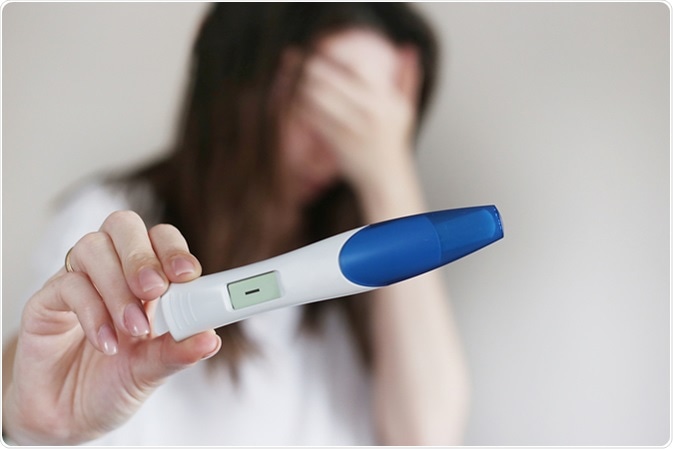Anovulation is a condition in which a woman’s ovaries do not release an egg (ovulate) regularly because the normal cycle of ovarian follicle maturation is disturbed.
There are many reasons why this happens, but in a large proportion of cases the cause is unidentified. Treatment of anovulation is usually performed in order to help a woman to conceive.

Negative pregnancy test. Image Credit: Lesya89 / Shutterstock
Treatment of Weight Disorders
Anovulation is most often due to polycystic ovarian syndrome(PCOS), in which the ovary is thickened and contains multiple cysts, androgen effects are visible in the woman’s body, and insulin resistance is present. PCOS is frequently, but not always, associated with infertility. Such women are quite often obese or overweight (body mass index above 30), and this contributes to the insulin resistance. They should be advised to pursue weight loss, because if even 5% of body mass is reduced there is a significant improvement in insulin sensitivity, luteinizing hormone (LH) and free testosterone levels also decrease, both of which lead to regularization of ovarian cycles in many patients.
On the other hand, women who have eating disorders or are severely malnourished, with a body mass index below 20, may have to gain a certain amount of weight before they resume ovulatory cycles. The anovulation should not be separately treated until the body mass becomes at least low-normal.
Hyperprolactinemia
High levels of a hormone called prolactin, which is secreted by the pituitary gland, can suppress ovulation. This can be due to the presence of a pituitary tumor called a microadenoma. It is safely and easily treated with a drug called bromocriptine, starting from a dosage of 1.25 mg and slowly increased to 2.5 mg over a month or so. Once the prolactin level falls below 1000 IU/L ovarian cycles normalize and become ovulatory in 70-80% of women. Other drugs used in this condition include cabergoline and quinagolide, which have a longer duration of action and less severe side effects than bromocriptine.
Hypothyroidism
In many women with anovulation the thyroid is underactive. The body attempts to compensate by secreting thyrotropin stimulating hormone (TSH) to stimulate thyroid hormone secretion, but this in turn stimulates prolactin production as well. This results in suppression of ovulation. Thus, any patient with high prolactin levels should be checked for primary hypothyroidism and treated with appropriate doses of thyroid hormone.
Medical Induction of Ovulation
Gonadotropin Releasing Hormone, GnRH
Women who have anovulation because of hypothalamic causes such as former eating disorders, rigorous exercise or stress, need to correct these abnormalities first. If they fail to start ovulating even after correction of these causes, pulsatile administration of GnRH is often offered, using an injection pump that delivers the hormone subcutaneously at regular intervals. This typically results in ovulation or the release of one egg from one mature follicle in either of the ovaries. This method achieves a high conception rate of 20-30% per cycle, with a cumulative incidence rate of 80-90% over 12 months of treatment.
Clomifene Citrate
Clomifene is a drug which blocks estrogen receptors in the pituitary gland which are responsible for blocking further production of gonadotropins. This receptor inhibition causes the levels of the gonadotropin follicle stimulating hormone, FSH, to rise, leading to the development of one or more dominant follicles in an ovary. Clomifene is therefore useful only in women with a functioning hypothalamus and pituitary gland. It is useful in PCOS, for instance, achieving ovulation in 70% of such women, with the conception rate at 6 months being 40-60%.
The risk with this mode of treatment is that FSH may rise too high, resulting in ovarian hyperstimulation syndrome (OHSS) in a small percentage of patients. This syndrome can be life-threatening and requires intensive care until controlled. Clomifene use is also associated with a higher risk of delivering twins or triplets. About 30% of successful conceptions following clomifene are multiple, but 20% of these end in miscarriages. Another long-term risk is the small increase in the risk of ovarian cancer if clomifene is used for more than a year, and therefore its use is now capped at 6 months in the UK.
Insulin Sensitizers
Metformin is a drug which increases the sensitivity of the body to insulin. It is used for weight loss and in diabetes mellitus, but off-label use in women with PCOS shows that it reduces hyperinsulinemia and brings down free testosterone levels, irrespective of body mass. This may help achieve ovulation in such women. Pioglitazone may be more effective at reducing insulin levels, while metformin helps to bring down the body weight.
Aromatase Inhibitors
Drugs such as letrozole and anastrozole are inhibitors of the enzyme aromatase. They were first used in treating hormone-responsive breast cancer, but have been since used to induce ovulation in PCOS in women who are resistant to treatment with clomifene, or are not suitable for treatment with clomifene or gonadotropins.
Statins
These drugs such as simvastatin were used to reduce cholesterol levels, but they also bring down testosterone concentrations in blood, and one study shows that they are superior to metformin alone (approximately 17% vs. 13.5%).
Follicle Stimulating Hormone (FSH)
Low doses of FSH are used in clomifene-resistant PCOS as well as in women with anovulation due to hypothalamic or pituitary causes. Like clomifene, it carries a high risk of multiple pregnancies, and especially of triplets and quadruplets, as well as of OHSS. Its use therefore demands expert and careful monitoring.
Surgical Treatment
Ovarian wedge resection was the first method of surgical treatment of PCOS but has now been replaced by laparoscopic ovarian diathermy or drilling, with the aim of reducing the quantity of androgen-secreting tissue within the ovary. It is quite as successful as FSH injections are, but the risks of multiple pregnancy and OHSS are significantly lower. However, if too much of the ovarian stroma is destroyed the woman may suffer premature ovarian failure. Again, if healing is complicated, it could lead to adhesion formation within the abdominal cavity.
Further Reading